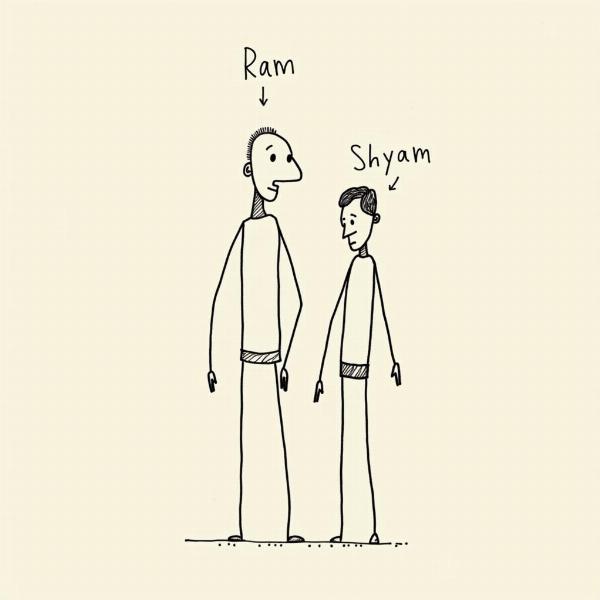Understanding the meaning of “than” in Hindi can be tricky, as there isn’t one single direct equivalent. The way “than” is translated depends heavily on the context of the sentence. Whether you’re comparing quantities, qualities, or making choices, knowing the correct Hindi equivalent is crucial for accurate communication. This article will explore the various ways to express the meaning of “than” in Hindi, providing examples and context to help you master this essential aspect of Hindi grammar.
Different Ways to Express “Than” in Hindi
Hindi employs several words and grammatical structures to convey the meaning of “than,” each tailored to a specific type of comparison. Let’s explore the most common ones:
Using “Se” (से) for Comparison
The most common way to express “than” in Hindi is using the postposition “se” (से). This is used when comparing two nouns or pronouns.
- Example: Ram is taller than Shyam. (राम श्याम से लंबा है। – Raam Shyam se lamba hai.)
“Se” follows the noun or pronoun being compared against. Notice how “Shyam” is followed by “se” in the example.
 Ram is taller than Shyam
Ram is taller than Shyam
Using “Ki Tulna Mein” (की तुलना में) for Comparison with “in comparison to”
For a more formal or literary comparison, “ki tulna mein” (की तुलना में) is used, which is equivalent to “in comparison to” or “compared to” in English.
- Example: The weather in Delhi is hotter than that in Mumbai. (दिल्ली का मौसम मुंबई की तुलना में अधिक गर्म है। – Dilli ka mausam Mumbai ki tulna mein adhik garm hai.)
This construction emphasizes the act of comparison itself, making it suitable for more analytical or descriptive contexts.
Using Comparative Adjectives
Hindi, like English, has comparative adjectives. These adjectives inherently imply a comparison and thus don’t require “se.”
- Example: This book is better than that one. (यह किताब उससे बेहतर है। – Yah kitaab usse behtar hai.) Here, “behtar” (बेहतर – better) already implies comparison. The word “usse” (उससे) refers to “that one.”
Using “Zyada” (ज़्यादा) and “Kam” (कम) for Quantity Comparisons
“Zyada” (ज़्यादा – more) and “kam” (कम – less) are used to compare quantities. They are often paired with “se” to complete the comparison.
- Example: I have more apples than oranges. (मेरे पास संतरों से ज़्यादा सेब हैं। – Mere paas santaron se zyada seb hain.)
Expressing Preference with ” बजाय” (बजाय)
“Bajay” (बजाय), meaning “instead of,” can be used to express a preference, which implicitly involves a comparison.
- Example: I would rather drink tea than coffee. (मैं कॉफ़ी के बजाय चाय पीना पसंद करूँगा। – Main coffee ke bajay chai peena pasand karunga.)
Understanding the Nuances of “Than” in Hindi
Mastering the use of “than” in Hindi requires understanding these subtle differences between the various methods. Choosing the right word or construction will make your Hindi more natural and precise.
Choosing the Right Word
While “se” is the most versatile and common option, using other forms like “ki tulna mein” or comparative adjectives can add nuance and sophistication to your Hindi. Consider the context and the specific type of comparison you’re making to choose the most appropriate word.
Conclusion
The meaning of “than” in Hindi can be conveyed in several ways, each with its own nuances. While “se” is the most common and versatile, understanding the appropriate use of “ki tulna mein,” comparative adjectives, and other constructions is crucial for accurate and natural-sounding Hindi. By practicing these different approaches, you can significantly enhance your ability to express comparisons effectively in Hindi.
FAQ
- What is the most common way to say “than” in Hindi? The most common way is using “se” (से).
- When should I use “ki tulna mein”? Use “ki tulna mein” (की तुलना में) for more formal or literary comparisons, similar to “in comparison to” in English.
- How do I compare quantities in Hindi? Use “zyada” (ज़्यादा) for “more than” and “kam” (कम) for “less than,” often combined with “se.”
- Is there a way to express preference using an equivalent of “than”? Yes, you can use “bajay” (बजाय), meaning “instead of,” to imply a preference and thus a comparison.
- Why are there different ways to say “than” in Hindi? Like many languages, Hindi uses different words and structures to express nuances within the concept of comparison.
Meaning-Hindi.in is your trusted partner for professional Hindi translation services. We offer a wide range of services, including business and commercial document translation, certified and legal document translation, technical and user manual translation, website and localization translation, educational and academic document translation, and express translation services. Our expertise covers a wide range of specialized fields. Contact us today for accurate, reliable, and culturally sensitive Hindi translations. Email: [email protected], Phone: +91 11-4502-7584. Meaning-Hindi.in is your one-stop solution for all your Hindi translation needs.